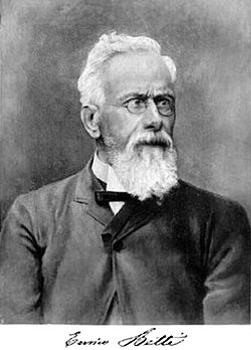Italian mathematician
Biographical Information
| Name: | Enrico Betti |
|---|---|
| Born on | 21 October 1823 in Pistoia, Pistoia, Tuscany, Italy, Europe |
| Deceased on | 11 August 1892 in Pisa, Pisa, Tuscany, Italy, Europe |
Short biography of Enrico Betti
After his father died when Enrico was very young, his mother brought him up alone. He later successfully completed studies in mathematics and physics at the University of Pisa. Under Mossotti’s leadership he fought in the battles of Curtatone and Montanara for Italian independence. Betti taught mathematics at Pistoia Grammar School and was invited to become professor at the University of Pisa. He remained loyal to his Alma Mater until his death and also served as rector; he also headed the Pisa Teacher Training College. He became a member of parliament in 1862 and was a senator from 1884 onwards. For a few months in 1874 he worked as second permanent secretary in the Ministry for Public Education. However, his talents brought forth more fruits in other fields: he was a skilled teacher and scientist and so he played a important role in mathematics and elastic theory after the Risorgimento. His reciprocal theorem formulated in 1872 proved critical for the development of elastic theory and structural theory: “If in an elastic, homogeneous body two displacement systems are in equilibrium with two groups of loads applied to the surface, then the sum of the products of the force components of the first system multiplied by the displacement components at the same point of the second system is equal to the sum of the products of the force components of the second system multiplied by the displacement components of the first system at the same point” [Betti, 1872]. This theorem, which represents a generalisation of Maxwell’s theorem [Maxwell, 1864/2], had already been incorporated by Mohr [Mohr, 1868]; in 1887 Robert Land had developed the reciprocal theorem independently from the work theorem, recognised its fundamental importance to classical structural theory and based his kinematic theory on this [Land 1887/2]. Betti’s contributions to algebra and the theory of functions were equally important.
Main contributions to structural analysis:
Teorema generale intorno alle deformazioni che fanno equilibrio a forze che agiscono alla superficie [1872]; Sopra l’equazioni d’equilibrio dei corpi elastici [1873–75]; Teoria della elasticità [1913]; Opere matematiche [1903–13]
Source: Kurrer, Karl-Eugen The History of the Theory of Structures, Wilhelm Ernst & Sohn Verlag für Architektur und technische Wissenschaften GmbH, Berlin (Germany), ISBN 3-433-01838-3, 2008; p. 716-717
Relevant Publications
- (2008): The History of the Theory of Structures. From Arch Analysis to Computational Mechanics. 1st edition, Wilhelm Ernst & Sohn Verlag für Architektur und technische Wissenschaften GmbH, Berlin (Germany), ISBN 978-3-433-01838-5, pp. 716-717.
- (2018): The History of the Theory of Structures. Searching for Equilibrium. 2nd edition, Wilhelm Ernst & Sohn Verlag für technische Wissenschaften, Berlin (Germany), ISBN 978-3-433-03229-9, pp. 971.
- About this
data sheet - Person-ID
1009696 - Published on:
25/04/2013 - Last updated on:
22/07/2014




